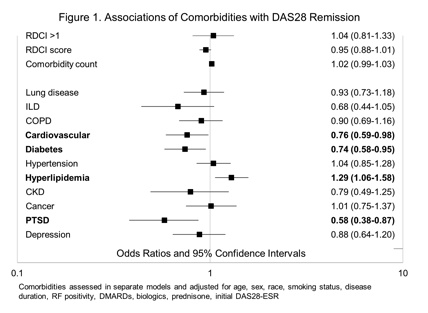Session Information
Session Type: ACR Poster Session A
Session Time: 9:00AM-11:00AM
Background/Purpose: Comorbidity frequently complicates rheumatoid arthritis (RA) leading to poor long-term outcomes. However, whether comorbidity influences measures of RA activity over time is less well established. The purpose of this study was to examine the association of different comorbidity assessments with longitudinal disease activity and functional status.
Methods: Participants were enrollees in a multicenter, longitudinal observational cohort of US veterans with RA. Comorbid conditions were collected at enrollment by treating rheumatologists and modeled using the Rheumatic Disease Comorbidity Index (RDCI) score, comorbidity count (range 0-53), or by the individual comorbid conditions. Disease activity (DAS28) and functional status (MD-HAQ) were assessed at routine clinic visits. Associations of comorbidity measures with disease activity and functional status over the initial 3 years of follow-up were examined using multivariable linear mixed effects models. Comorbidity measures were examined as main effects as well as by using interaction terms with time, the latter to examine whether a given measure was associated with diverging disease activity and functional status trajectories over follow-up. The odds of ever achieving DAS28 remission (<2.6) were examined using multivariable logistic regression.
Results: Among 2,516 participants with mean age of 64 (SD 11) years, RA duration 11 (11) years, 90% male, 79% RF positive, 78% anti-CCP positive, and 80% with smoking history, 75% had a RDCI ³1. Hypertension (53%), hyperlipidemia (41%), lung (20%), and cardiovascular (CV) disease (19%) were the most prevalent comorbidities. Comorbidity, measured by RDCI ³1, count, or RDCI score, was not associated with longitudinal disease activity or remission (Table 1, Figure 1) although comorbidity count and RDCI score were associated with reduced physical function (Table 1). Select individual comorbidities, including CV, lung, and psychiatric disease, were more closely associated with unfavorable longitudinal disease activity, remission achievement, and physical function (Table 1, Figure 1). CV and interstitial lung disease (ILD) were the only comorbidities with a significant time-interaction term (DAS28 models), suggesting a widening gap in disease activity over time for these conditions.
Conclusion: CV, lung, and psychiatric comorbidities, but not composite comorbidity scores, are associated with higher measures of disease activity and lower odds of achieving remission in RA. Specific comorbidities and composite measures are associated with longitudinal functional status.
|
Table 1. Associations of comorbidities with longitudinal disease activity and functional status. |
||
|
|
log DAS28 _ (Std Error) |
MD-HAQ _ (Std Error) |
|
Composite measures |
|
|
|
RDCI ³1 |
-0.017 (0.025) |
0.034 (0.039) |
|
RDCI score |
0.002 (0.006) |
0.048 (0.010)** |
|
Comorbidity count
|
0.000 (0.002) |
0.016 (0.003)** |
|
Individual conditions |
|
|
|
Lung disease |
-0.002 (0.023) |
0.109 (0.035)** |
|
Interstitial lung disease (ILD) |
-0.093 (0.042) ± |
0.032 (0.064) |
|
ILD x time (years) |
0.079 (0.012)** |
– |
|
COPD |
0.021 (0.025) |
0.132 (0.037)* |
|
Cardiovascular (CVD) |
-0.012 (0.024) ± |
0.081 (0.036)* |
|
CVD x time (years) |
0.044 (0.016)** |
– |
|
Diabetes mellitus |
0.001 (0.024) |
0.079 (0.036)* |
|
Hypertension |
-0.013 (0.020) |
0.021 (0.030) |
|
Hyperlipidemia |
-0.039 (0.019) |
0.047 (0.029) |
|
Chronic kidney disease |
0.006 (0.044) |
0.094 (0.066) |
|
Cancer |
-0.030 (0.030) |
0.006 (0.044) |
|
PTSD |
0.177 (0.038)** |
0.206 (0.058)** |
|
Depression |
0.093 (0.031)** |
0.157 (0.046)** |
|
Covariates: RF, current smoking, DMARD, biologic DMARD, prednisone + (DAS28) smoking*time (MD-HAQ) education, race, disease duration. * p < 0.05, ** p < 0.01 ± Result from model with a significant comorbidity x time interaction term Abbreviations: RDCI Ð rheumatic disease comorbidity index; COPD Ð chronic obstructive pulmonary disease; PTSD Ð post-traumatic stress disorder
|
||
To cite this abstract in AMA style:
England BR, Sayles H, Michaud K, Cannon G, Reimold A, Caplan L, Kerr GS, Singh N, Haynatzki G, George MD, Baker J, Mikuls TR. Comorbidity Measures Differentially Predict Longitudinal Disease Activity, Remission, and Disability in Rheumatoid Arthritis [abstract]. Arthritis Rheumatol. 2017; 69 (suppl 10). https://acrabstracts.org/abstract/comorbidity-measures-differentially-predict-longitudinal-disease-activity-remission-and-disability-in-rheumatoid-arthritis/. Accessed .« Back to 2017 ACR/ARHP Annual Meeting
ACR Meeting Abstracts - https://acrabstracts.org/abstract/comorbidity-measures-differentially-predict-longitudinal-disease-activity-remission-and-disability-in-rheumatoid-arthritis/

